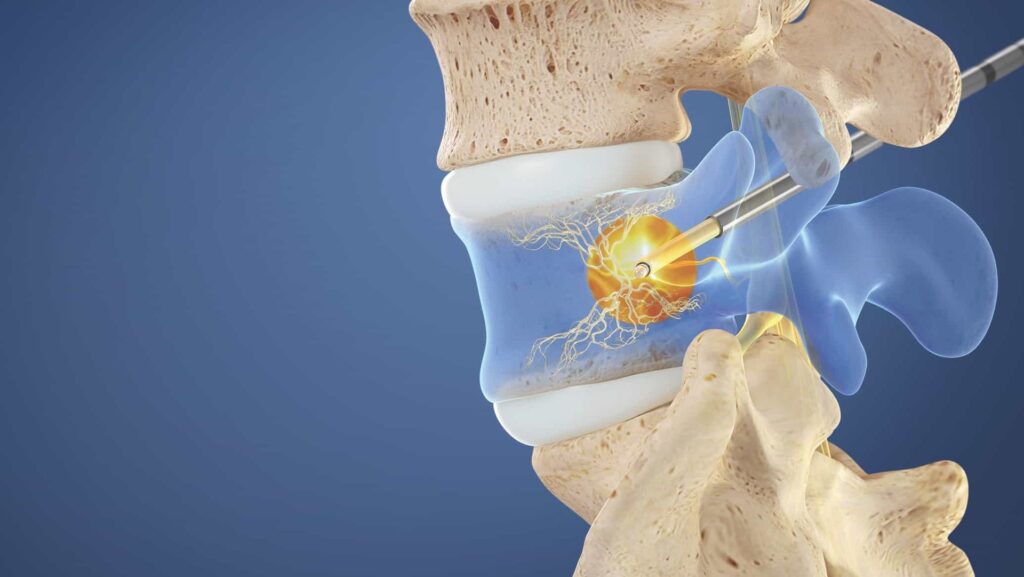Basivertebral Nerve Ablation
Basivertebral nerve ablation (BVNA) offers a focused, minimally invasive approach to treating vertebrogenic low back pain—pain that originates from inflammation and damage within the vertebral endplates. This type of chronic pain is often identified through imaging studies that reveal Modic changes, a common sign of vertebral endplate degeneration. Unlike traditional treatments that may only mask symptoms, BVNA addresses the source of the pain by targeting the nerve responsible for transmitting it.
This outpatient procedure can offer long-lasting relief for patients whose pain has not improved with physical therapy, medications, or injections. Because it is performed through a small incision with minimal disruption to surrounding tissues, recovery is typically faster and more comfortable than traditional spine surgery.

What is it?
Basivertebral nerve ablation is a minimally invasive procedure designed to treat chronic low back pain that originates from vertebral body endplates. This procedure specifically targets the basivertebral nerve, which carries pain signals from damaged or degenerated vertebrae.
How is it performed?
The procedure is performed under fluoroscopic (X-ray) guidance and typically takes 15-20 minute per level treated. Using precise imaging, your physician will guide a specialized probe through a small incision to reach the basivertebral nerve. Radio-frequency energy is then used to disable the nerve’s ability to transmit pain signals.
Technology Partners:
Relievant’s Intracept
Keypoint #1-Lorem Ipsum
Lorem Ipsum mon fringilla dolor felis amet fusce.
• Libero auctor
• Enim molestie iaculis
• Massa bibendum
• Ultrices varius
Metus euismod tellus penatibus in ex morbi euismod mollis.
Phasellus venenatis augue luctus sollicitudin elementum suspendisse.
Treatment Benefits
Basivertebral nerve ablation can significantly reduce or eliminate deep, aching back pain linked to vertebral endplate inflammation. By interrupting the pain signals at their origin, patients may experience improved mobility, better sleep, and a decreased need for pain medications. The procedure is durable, low-risk, and has been shown to provide lasting relief in patients with confirmed vertebrogenic pain.
Who Can Benefit From This Treatment
This procedure is ideal for patients with chronic low back pain lasting six months or more that has not responded to conservative care. Candidates often have MRI-confirmed Modic Type 1 or Type 2 changes—indicating inflammation or degeneration at the vertebral endplates. A careful diagnostic process, including clinical evaluation and imaging, helps determine if basivertebral nerve ablation is the right solution.
Learn more about Basivertebral Nerve Ablation by contacting the Minimally Invasive Spine and Pain Institute—our team is here to help you explore your options.
Aftercare for Basivertebral Nerve Ablation
Following basivertebral nerve ablation, most patients can return home the same day and resume light activities within 24 to 48 hours. Some mild soreness or stiffness at the incision site or in the lower back is normal and should improve within a few days. Because the procedure is minimally invasive and avoids major tissue disruption, recovery is typically straightforward. It may take several weeks for the full effects of the treatment to be felt as the inflammation in the vertebrae subsides.
Tips for a Smooth Recovery
Follow these guidelines to support healing after basivertebral nerve ablation:
Avoid strenuous activity, heavy lifting, or twisting for several days
Use over-the-counter pain medication or cold packs to manage minor discomfort
Maintain gentle movement, such as walking, to promote circulation and flexibility
Keep the incision site clean and dry to prevent infection
Report any unusual or worsening symptoms to your provider

